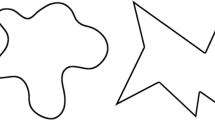Abstract
Both frequency and speed of utterance have been implicated in studies of phonetic symbolism. Therefore, these two variables were manipulated independently. Three monosyllables were recorded and distorted by either increasing or decreasing frequency, holding speed constant, and by increasing or decreasing speed, holding frequency constant. The subjects were 15 college students who rated the resulting 15 stimuli (3 monosyllables X fast speed-normal frequency, slow speed-normal frequency, normal speed-high frequency, normal speed-low frequency, and normal speed-normal frequency) using 15 bipolar adjective scales, chosen on the basis of previous semantic differential and phonetic symbolism research. Five separate factor analyses were applied to the data. It was found that the normal speed-low frequency, slow speed-normal frequency, and normal speed-normal frequency stimuli generated approximately the same factors, while the fast speed-normal frequency and normal speed-high frequency stimuli generated factors similar to each other but with some notable differences. Separate analyses of variance were applied to the bipolar adjectives using speed, frequency, and vowels as main effects. The 15 analyses showed that subjects did judge the monosyllables as different on the basis of both speed and frequency. The implications of this study for phonetic symbolism research are discussed.
Similar content being viewed by others
References
Brown, R.Words and things, New York: Free Press of Glencoe, 1958.
Brown, R. W., Black, A. H. & Horowitz, A. E. Phonetic symbolism in natural languages.Journal of Abnormal and Social Psychology, 1955,50, 388–393.
Daniloff, R. G., Shriner, T. H., & Zemlin, W. R. Intelligibility of vowels altered in duration and frequency.Journal of the Acoustical Society of America, 1968,44, 700–707.
Denes, P. B. & Pinson, E. N.The speech chain: The physics and biology of spoken language. Garden City, New York: Anchor Press/Doubleday, 1973.
Eberhardt, M. A study of phonetic symbolism in deaf children.Psychological Monographs, 1940,52, 23–41.
Fischer-Jorgensen, E. On the universal character of phonetic symbolism with special reference to vowels.Studia Linguistica, 1978,32, 80–90.
Foulke, E., & Sticht, T. G. Review of research on the intelligibility and comprehension of accelerated speech.Psychological Bulletin, 1969,72, 50–62.
Jespersen, O.Language: Its nature, development, and origin London: Allen and Unwin, 1922.
Kurtzrock, G. H. The effects of time and frequency distortion upon word intelligibility.Speech Monographs, 1957,24, 94.
Ladefoged, P.A course in phonetics. New York: Harcourt Brace Jovanovich, 1975.
Laver, J.The phonetic description of voice quality. Cambridge: Cambridge University Press, 1980.
Miron, M. S. A cross-linguistic investigation of phonetic symbolism.Journal of Abnormal and Social Psychology, 1961,62, 623–630.
Newman, S. Further experiments in phonetic symbolism.American Journal of Psychology, 1933,45, 53–75.
O'Boyle, M. W., & Tarte, R. D. Implications for phonetic symbolism: The relationship between pure tones and geometric figures.Journal of Psycholinguistic Research, 1980,9, 535–544.
Osgood, C., Suci, G., & Tannenbaum, P.The measurement of meaning. Urbana: University of Illinois Press, 1957.
Sapir, E. A study in phonetic symbolism.Journal of Experimental Psychology, 1929,12, 225–239.
Tarte, R. D. Phonetic symbolism in adult native speakers of Czech.Language and Speech, 1974,17, 87–94.
Tarte, R. D.Phonetic symbolism for pure tones. Paper presented at the November meeting of the Psychonomic Society, St. Louis, 1976.
Tarte, R. D.The relationship between monosyllables and pure tones: An investigation of phonetic symbolism.Journal of Verbal Learning and Verbal Behavior, 1982,21, 352–360.
Tarte, R. D., & Barritt, L. S. Phonetic symbolism in adult native speakers of English: Three studies.Language and Speech, 1971,14, 158–168.
Taylor, I. K. Phonetic symbolism re-examined.Psychological Bulletin, 1963,60, 200–209.
Taylor, I.Introduction to psycholinguistics. New York: Holt, Rinehart & Winston, 1976.
Taylor, I. K., & Taylor, M. M. Another look at phonetic symbolism,Psychological Bulletin, 1965,64, 413–427.
Wallace, W. P., & Koury, G. Transfer effects from listening to frequency-controlled and frequency-shifted accelerated speech.Journal of Speech and Hearing Research, 1981,24, 185–191.
Author information
Authors and Affiliations
Rights and permissions
About this article
Cite this article
Tarte, R.D., O'Boyle, M.W. Semantic judgments of compressed monosyllables: Evidence for phonetic symbolism. J Psycholinguist Res 11, 183–196 (1982). https://doi.org/10.1007/BF01067562
Accepted:
Issue Date:
DOI: https://doi.org/10.1007/BF01067562




